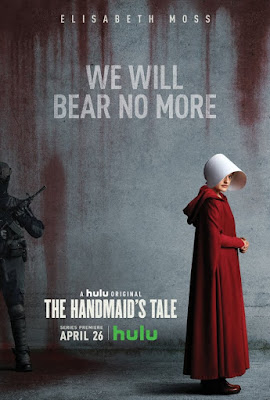I’ve been bingeing on episodes of The Handmaid’s Tale on Hulu. What a strange yet intriguing story. A long time ago we had 1984, George Orwell’s tale of a Big Brother dystopia. We called such a view an Orwellian society. Now we have Margaret Atwood’s version. I’d want to call it an Atwoodian society but that doesn’t sound right, so I’m revising both words—Orwellen and Atwooden. In 1984, Winston Smith lives in Oceania, watched night and day by the Party’s telescreens to guard against all thought crime, or any expressions of individuality. The Party is led by a mysterious figure known as Big Brother. The Party not only keeps all its citizens under an omnipresent eye, it also controls their thoughts with a kind of brainwashing doubletalk called Newspeak. For example, “2 + 2 = 5,” “Freedom is Slavery,” “Goodsex is chastity,” this last example meaning that intercourse, especially for women, shouldn’t be pleasurable but only for procreation. They even employed a system in which the past could be changed by simply changing it in all books and papers. Their belief: the past doesn’t exist except as we create it. Sort of like Donald Trump’s concept of fake news. Today, we seem to be embarking on our own brand of euphemistic doublespeak—IED (bomb), downsize (fire, as in disemploy), person of interest (suspect), pre-owned (used), terminate (kill or disemploy), to name only a few. But you get the drift.
Atwood must surely have been influenced by 1984 when she wrote The Handmaid’s Tale. The society that parallels Orwell's Oceania is known as Gilead. According to the leaders of this new society, God has chosen to punish mankind for our mistreatment of Earth by making all but a very few women sterile, with the likelihood that nearly all of mankind will soon be gone except for the few children born to the handmaids, those few women still able to become pregnant. Sharon, or Offred as she is now called in Gilead, is one of the few fertile women. She and the other handmaids are kept like prisoners, punished severely for any improprieties. One of them had her eye “plucked out” for not being religiously pious during one of the training periods. One of the Aunts (an older woman incapable of giving birth but an avowed follower of Gilead and its new society) regularly used a cattle prod to burn any misbehaving handmaids.
The female categories are all marked by the color of their apparel—green for the wives of party leaders, brown for the Aunts, gray for the Marthas (those who performed the housekeeping for party leaders), and red for the handmaids. Offred has been assigned to the household of commander Waterford and Mrs. Waterford, where she does menial household chores like shopping and once months engages in “The Ceremony,” Gilead’s solution for dispassionate intercourse. On the night of The Ceremony, the handmaid lies on a bed between the legs of the wife, who holds the handmaid’s arms while the husband performs the oh so very dispassionate insemination. All is for the welfare of the society, the procreation of children, and none for the pleasure of intercourse.
Much of the filming is done in shades of white and black, with most of the scenes dominated by red, gray, green, and brown. The story is told in the present with flashbacks to the time before the uprising of Gilead, back to Sharon and Luke’s marriage and their life with a daughter, back to the pre-Gilead lives of all the characters. It seems like they could never run out of plot strands with that many potential flashbacks, very similar to what we had with that other successful series, Lost. The most relevant thing about The Handmaid’s Tale is Elisabeth Moss as Offred, I remember her when she was the president’s daughter Zoe on The West Wing. Now she’s all grown up and one of the best actresses in the business. She recently won the Emmy for best female actress in a television drama, and The Handmaid’s Tale winning for best television dramatic series. And what I find most curious of all, she’s not particularly attractive, willing to show herself to the audience in full-facial close-ups without cosmetic magic, with all warts and blemishes showing. She did this same superior acting in Mad Men and both Sundance originals of Top of the Lake.
After I finish my binge, I’m going to read the novel to see what changes were made for the television version.

I've always collected errors in diction, things people mis-hear, like "windshield factor" and "the next store neighbors." Years ago, one of my students wrote an essay in which she described the world as being harsh and cruel, "a doggy-dog world." I've since come to think she may have been more astute and accurate than those who describe it in the usual way. My Stories - Mobridge Memories -
About Me
Translate
Most of what I've written has been published as e-books and is available at Amazon. Match Play is a golf/suspense novel. Dust of Autumn is a bloody one set in upstate New York. Prairie View is set in South Dakota, with a final scene atop Rattlesnake Butte. Life in the Arbor is a children's book about Rollie Rabbit and his friends (on about a fourth grade level). The Black Widow involves an elaborate extortion scheme. Happy Valley is set in a retirement community. Doggy-Dog World is my memoir. And ES3 is a description of my method for examining English sentence structure.
In case anyone is interested in any of my past posts, an archive list can be found at the bottom of this page. I'd appreciate any feedback you may have by sending me an e-mail note--jertrav33@aol.com. Thanks for your interest.

No comments:
Post a Comment